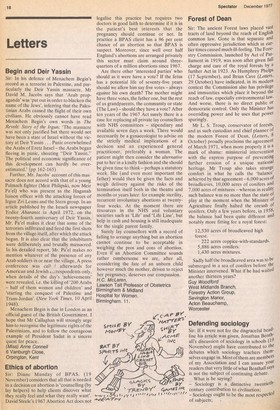Forest of Dean
Sir: The ancient Forest laws placed vast tracts of land beyond the reach of English common law. Gone is that separate and often oppressive jurisdiction which in earlier times caused much ill-feeling. The Forestry Commission, launched by Act of Parliament in 1919, was soon after given full charge and care of the royal forests by a further Act in 1923. As Humphrey Phelps (17 September), and Brian Cave (Letters, 29 October) have indicated, in its modern context the Commission also has privilege and immunities which place it beyond the reach of law, especially environmental law. And worse, there is no direct public or democratic control. Only the Minister has overriding power and he uses that power sparingly.
Mr L. S. Troup, conservator of forests, and as such custodian and chief planner of the modern Forest of Dean, (Letters, 8 October) proudly proclaims the agreement of March 1971, when more properly it is a mark of shame: ministerial intervention with the express purpose of preventing further erosion of a unique national heritage. Mr Troup also takes strange comfort in what he calls the 'balance achieved by that agreement —6,000 acres of broadleaves, 10,000 acres of conifers and 7,000 acres of mixtures — whereas in reality such balance was no more than the state of play at the moment when the Minister of Agriculture finally halted the onrush of conifers. Only a few years before, in 1958, the balance had been quite different and notably more fitting for a royal forest: 12,530 acres of broadleaved high forest.
222 acres coppice-with-standards. 5,886 acres conifers. 1,430 acres mixtures.
Sadly half the broadleaved area was to be submerged in a sea of conifers before the Minister intervened. What if he had waited another thirteen years?
Guy Woodford West Midlands Branch, Forestry Action Group, Sevington Manor, Acton Beauchamp, Worcester










































 Previous page
Previous page